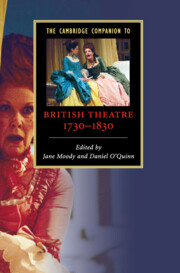Book contents
- Frontmatter
- Part I Performance
- 1 Acting and actors from Garrick to Kean
- 2 Dictating to the empire: performance and theatrical geography in eighteenth-century Britain
- 3 Scenography and technology
- 4 Spectatorship
- Part II Genres
- Part III Identities
- Part IV Places of Performance
- Part V Further Reading
- Bibliography
- Index
- Series list
3 - Scenography and technology
from Part I - Performance
Published online by Cambridge University Press: 28 May 2009
- Frontmatter
- Part I Performance
- 1 Acting and actors from Garrick to Kean
- 2 Dictating to the empire: performance and theatrical geography in eighteenth-century Britain
- 3 Scenography and technology
- 4 Spectatorship
- Part II Genres
- Part III Identities
- Part IV Places of Performance
- Part V Further Reading
- Bibliography
- Index
- Series list
Summary
Probably the most significant difference between a play written and produced in the mid eighteenth century and one written and produced a hundred years later would be the reliance upon pictorial scenography in the latter. In 1740, with some significant exceptions, the space of the production would display the formal qualities of a scenically neutral theatrical place. This was a place of performance in which scenery served as a decorative background to dramatic action. By 1840 the physical presence of scenic techniques and effects would underpin almost all aspects of production as major elements within dramaturgy and the theatrical experience.
By 1840 the neutral place of performance had been replaced by detailed scenic representations of other worlds involving sophisticated theatrical processes and techniques. This new place of performance was situated within its own discrete architectural space, one that was separated from the audience by a decorated proscenium frame through which the audience looked. Throughout this process of change, important physical and psychological distinctions were established between audience and stage. Fundamentally, however, it would be true to say that spectators in 1740 might have considered it a heresy to connive at losing their sense of identity in the theatre. For that audience, the act of becoming engaged in performance involved balancing a social sense of self alongside admiration of the performer's skill in taking them over the threshold of belief into the world of the play. By 1840 every possible aspect of architecture, scenography and its associated technologies was being used in order to transport the spectator's imagination into the 'other worlds' which the theatre sought to (re)create.
- Type
- Chapter
- Information
- The Cambridge Companion to British Theatre, 1730–1830 , pp. 43 - 56Publisher: Cambridge University PressPrint publication year: 2007
- 4
- Cited by

